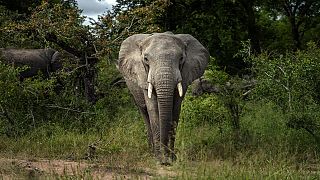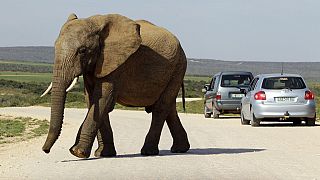South Africa
Charley was until recently the last captive elephant in South Africa. He has started a new life in a private game reserve after 40 years of captivity.
When it comes to the niche business of moving elephants, Dr. Amir Khalil and his team might be the best.
The Egyptian veterinarian's résumé includes possibly the most famous elephant relocation on the planet.
In 2020, Khalil's team saved Kaavan, an Asian elephant, from years of loneliness at a Pakistan zoo and flew him to a better life with other elephants at a sanctuary in Cambodia.
Kaavan was dubbed the "world's loneliest elephant" at the time, and the project was a great success.
But he was not the only one that needed help.
Next up was the last captive elephant in South Africa.
Charley, an aging four-ton African elephant, had outlived his fellow elephants at a zoo in the capital, Pretoria, where he'd lived for more than 20 years.
The mechanics of moving an elephant
Elephants are sensitive animals, wildlife experts say, and Charley was showing signs of being deeply unhappy in his enclosure since his partner, Landa, died in 2020.
Zoo officials decided he should be “retired” to a place more fitting for a big old tusker — a large private game reserve some 200 kilometers (120 miles) away where there's a chance he might make some new elephant friends.
How to get him there? Khalil, an animal rescue specialist at the Four Paws wildlife welfare organization, was an obvious choice for this latest mammoth job.
If ever an elephant deserved to enjoy his twilight years, it's Charley.
Captured as a young calf in western Zimbabwe in the 1980s and taken from his herd, he spent 16 years in a South African circus and 23 years as the prime attraction at Pretoria's National Zoological Garden.
He's thought to be 42 years old now and has spent 40 of them in captivity.
The mechanics of moving an elephant to a new life are complex.
Khalil doesn't dart and tranquilize elephants, mainly because it's not good for such a big animal.
Also, four tons of tranquilized elephant is hardly any easier to move.
And so, a process began of training an occasionally grumpy old elephant to step willingly into a large metal transport container that will be loaded onto a truck.
Khalil and fellow vets Dr. Marina Ivanova and Dr. Frank Göritz — who were also part of the Kaavan relocation team — first began interacting with Charley two years ago.
That was to assess how ready he was to move and, crucially, to earn his trust.
The interaction was carefully controlled, but it involved teaching Charley to respond to calls to walk up to a "training wall" that has gaps in it for the team to offer him a food reward.
In Charley's case, pumpkins, papaya and beetroot are his favorites.
The same process was ultimately used to entice Charley into the transport container.
It was thought that it might take months and months for Charley to step happily into the container when that was introduced, but he was ready to go in less than two weeks of crate training last month.
After an hours-long road trip on the back of a truck, Charley was introduced to his new home at the Shambala private game reserve in late August.
He'll be held in an area separate from the main park for a few weeks to allow him to settle, the team said, given such a huge change for an old elephant.
The park contains wild elephant herds that Charley may join up with.
Khalil said it is still very rare for captive elephants to be reintroduced to a wild setting and praised officials at the Pretoria zoo and South Africa's environment ministry for allowin












00:57
Kiteboarding sees competitors reach new heights in South Africa
02:00
South African project helps deaf people build farming skills and find jobs
Go to video
USA: McKinsey pays fine for corruption in South Africa
01:09
Six bodies retrieved from illegal goldmine in South Africa
01:02
South Africa poised to take over the leadership of the G20 on Sunday
01:26
Namibia: voting underway as the country gears towards new leadership